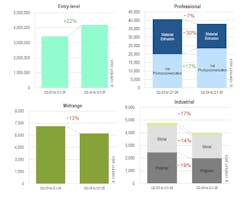Market Intelligence on the Divergent Paths of 3D Printer Segments
The global 3D printer market has exhibited sharply divergent trends heading into 2025, as highlighted by a recent analysis by the global market intelligence firm Context. Amid challenges such as tariff wars, inflation and rising interest rates, it seems significant shifts are altering the dynamics of this market. Three key trends defined Q1 2025.
Growth in entry-level printers. The most striking trend is the marked growth in entry-level 3D printers, which saw shipments increase by 15% year-on-year, according to the report. This revival stems from proactive purchasing by consumers and channel partners anticipating tariffs on Chinese imports. With entry-level systems priced under $2,500, they cover a broad spectrum of applications, providing an accessible option for engineers looking to implement rapid prototyping, iterative design and experimentation into their workflows.
The readers of Machine Design might see these as a cost-effective solution to accelerate design processes, rapidly assess new concepts and produce functional prototypes without substantial financial commitments.
Challenges in industrial and midrange sectors. On the flip side, the industrial and mid-range segments are navigating a more turbulent environment. Shipments in these categories experienced significant declines—14% for industrial systems and 16% for mid-range systems—primarily due to high interest rates constraining capital spending on expensive systems, according to the analysis.
Although industrial revenues experienced an overall decline of -6% YoY in Q1, this decrease is reported to be somewhat mitigated by rising average selling prices for advanced Metal Powder Bed Fusion (PBF) systems from vendors such as Eplus3D and Nikon SLM Solutions. Demand for advanced multi-laser, large build-volume metal PBF systems continued to be a bright spot in the global additive market, with these two vendors maintaining their leadership.
For mid-range 3D printer shipments, Chinese vendors—mostly fulfilling domestic demand—fared better than Western vendors in the period, with shipments from UnionTech rising 13%. The standout vendor in this price class (on a TTM basis) is Flashforge thanks to strong Asia Pacific and Middle East sales of their material jetting printer to the jewelry market. Over the trailing-12-month period, established Western companies such as Stratasys, 3D Systems and Formlabs saw sales fall, contributing to a -13% drop in global shipments on a TTM basis, according to the analysis.
Diverging trends in professional printer technologies. The professional printer category, encompassing systems priced between $2,500 and $20,000, reflects substantial technology shifts. Material extrusion (predominantly FDM/FFF) technologies have seen a significant drop in demand, at -31% and down -30% over the TTM. In contrast, vat photopolymerization technologies have surged by 19% YoY, with new mSLA offerings from vendors like Formlabs and SprintRay, revitalizing the segment. Formlabs’ 40% shipment growth in the first quarter keeps them in the share lead in this price class, according to Context’s analysis.
Mechanical engineers focusing on precision and detail could benefit from the shift toward advanced photopolymerization technologies, which offer superior resolution and the surface finish necessary for highly detailed parts or complex assemblies.
Future Outlook: Navigating Economic Challenges
The economic landscape in Q1 2025 presents ongoing challenges leading to conservative forecasts for higher-end 3D printing systems. Economic factors are expected to persist through 2025 with meaningful recovery forecasted only into 2026. Engineers might want to strategically plan for potential delays in design iterations or project timelines related to these economic conditions.
Despite these challenges, the underlying demand for industrial systems remains strong, according to Context, with many OEMs focusing on profitability rather than market share. The notable growth in entry-level printers presents significant opportunities for innovation and faster iteration cycles, while the challenges in the industrial and mid-range sectors necessitate agility and strategic planning.
“While the immediate forecast is challenging, there remains strong underlying pent-up demand, particularly for industrial systems,” Connery said in the press release. “OEMs still report high levels of customer interest, and the industry is poised to rebound once macroeconomic conditions improve. We expect a gradual recovery to begin in 2026 as interest rates fall and stimulate renewed capital spending, similar to the surge seen after the Covid lockdowns.”
About the Author
Sharon Spielman
Technical Editor, Machine Design
As Machine Design’s technical editor, Sharon Spielman produces content for the brand’s focus audience—design and multidisciplinary engineers. Her beat includes 3D printing/CAD; mechanical and motion systems, with an emphasis on pneumatics and linear motion; automation; robotics; and CNC machining.
Spielman has more than three decades of experience as a writer and editor for a range of B2B brands, including those that cover machine design; electrical design and manufacturing; interconnection technology; food and beverage manufacturing; process heating and cooling; finishing; and package converting.
Email: [email protected]
LinkedIn: @sharonspielman
Facebook: Machine Design
YouTube: @MachineDesign-EBM


